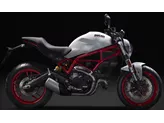Kawasaki Z650 2017 vs. Kawasaki Z900 2017

Kawasaki Z650 2017

Kawasaki Z900 2017
Overview - Kawasaki Z650 2017 vs Kawasaki Z900 2017
The Kawasaki Z650 2017 and the Kawasaki Z900 2017 are both naked bikes with similar engine types, fuel systems, and cooling systems. However, there are several key differences between the two models.
In terms of engine power, the Z650 has 68.2 HP, while the Z900 boasts a more powerful 125.4 HP. The Z900 also has a higher torque of 98.6 Nm compared to the Z650's 65.7 Nm. This means that the Z900 offers more acceleration and overall power, making it suitable for riders who crave a more thrilling and dynamic riding experience.
Both bikes feature a swing arm rear suspension with a monoshock, but the Z650 only has preload adjustment, while the Z900 has both preload and rebound adjustment. This allows riders to fine-tune the suspension to their preferences and riding style. Additionally, the Z900 has an upside-down telescopic fork for the front suspension, which provides better stability and control during aggressive riding.

Kawasaki Z650 2017
The chassis of both bikes is made of steel, but the Z900 has a double cradle frame, which offers improved rigidity and handling compared to the tubular frame of the Z650. This makes the Z900 more stable and responsive in corners and at higher speeds.
When it comes to braking, both bikes have double disk brakes at the front with a diameter of 300 mm. However, the Z900 has four-piston calipers, providing better stopping power and control compared to the Z650's double-piston calipers. Both bikes also feature ABS as an advanced rider assistance system, ensuring safe and controlled braking in various conditions.
In terms of dimensions and weights, the Z900 has a slightly larger wheelbase of 1450 mm compared to the Z650's 1410 mm. The Z900 also has a slightly higher seat height of 795 mm, which may be less comfortable for taller riders. However, both bikes have similar front and rear tire dimensions, with the Z900 having a slightly wider rear tire of 180 mm compared to the Z650's 160 mm. The Z900 is also slightly heavier, with a kerb weight of 210 kg compared to the Z650's 187.1 kg.

Kawasaki Z900 2017
In terms of strengths, the Z650 offers even power delivery, a sporty chassis, compact dimensions, and a negative display. On the other hand, the Z900 is praised for its ingenious naked bike chassis, superb looks, responsive engine with perfectly dimensioned torque, and its optimum intersection of performance, price, and practical use.
In terms of weaknesses, the Z650 is considered a little too small for tall people, while the Z900 has a narrow knee angle for taller riders. However, this can be addressed by ordering a different seat for the Z900.
Overall, the Kawasaki Z650 2017 is a capable and enjoyable naked bike with good power and handling, suitable for riders of various heights. The Kawasaki Z900 2017, on the other hand, offers a more powerful engine, improved suspension adjustability, and a more rigid chassis, making it a more performance-oriented option, albeit with some considerations for taller riders.
Technical Specifications Kawasaki Z650 2017 compared to Kawasaki Z900 2017
Pros and Cons in comparison
Pros and Cons in comparison
Kawasaki Z650 2017

The Kawasaki Z 650 is the tip of the middle class for small male and female riders. On its compact dimensions, you probably won't feel comfortable as a giant. Heart-warming feelings, however, come from the engine, which delights with a very smooth pull. On the chassis side, a Kawasaki-typical tight set-up was chosen, which finds a great compromise in everyday use. The negative display is very easy to read and is reminiscent of its predecessor, the ER-6n - very nice!
Kawasaki Z900 2017

An incredibly well-designed motorbike. A lot of test work and attention to detail went into it. It has exactly the right power, exactly the right chassis and exactly the right look. An all-round successful naked bike that will make you happy for a long time. If you like, you can ride it simply and faithfully, but if you want, you can also ride it really fast and it wheels like hell. Great!
Price Comparison Avarage Market Price Kawasaki Z650 vs Kawasaki Z900
There are a few key differences between a Kawasaki Z650 2017 and a Kawasaki Z900 2017. In terms of price, the actual average price of a Kawasaki Z900 2017 is about 46% higher. A Kawasaki Z650 2017 experiences a loss of 340 USD in one year and 520 USD in two years of ownership. This is offset by a loss of 520 USD and 920 USD for a Kawasaki Z900 2017. Compared to Kawasaki Z900 2017 there are less Kawasaki Z650 2017 bikes available on the 1000PS.de Marketplace, specifically 11 compared to 43. It takes less time to sell a Kawasaki Z650 with 76 days compared to 85 days for a Kawasaki Z900. Since model year 2017 1000PS.de editors have written 31 reviews for the Kawasaki Z650 and 46 reviews for the Kawasaki Z900 since model year 2017. The first review for the Kawasaki Z650 was published on 11/8/2016 and now has more than 25,000 views. This compares to more than 93,200 views for the first review on Kawasaki Z900 published on 11/11/2016.






















